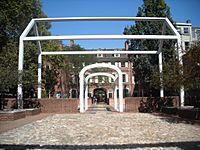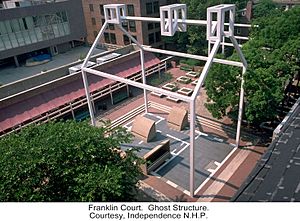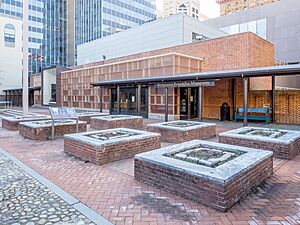Franklin Court facts for kids

One of Venturi & Rauch's "ghost structures" in the courtyard
|
|
| Established | 1976 |
|---|---|
| Location | Independence National Historical Park, Philadelphia, Pennsylvania |
| Type | Biographical museum |
| Public transit access | 5th Street/Independence Hall |
Franklin Court is a special place in Philadelphia, Pennsylvania, located inside Independence National Historical Park. It's a collection of museums, buildings, and historic spots. This is where Benjamin Franklin, a famous American printer, scientist, diplomat, and statesman, lived in Philadelphia from 1763 until he passed away in 1790.
The design for Franklin Court was created by the architectural firm Venturi and Rauch. It opened in 1976, just in time for the United States Bicentennial – a big celebration of America's 200th birthday! At the site, you can see the old foundations of Franklin's house and other buildings. There are also "ghost structures" made of metal that show where his house and print shop used to stand. Below ground, there's a museum all about Benjamin Franklin. Plus, there are historic buildings facing Market Street that now include a working post office and a printing shop.
Contents
History of Franklin's Home
This court was the location of the house that Benjamin Franklin had built in 1763. He owned this house until he died in 1790. Even though Franklin was often traveling overseas during those years, he spent a lot of time in Philadelphia. He was very involved with important events like the Second Continental Congress and the United States Constitutional Convention. Franklin permanently moved into the house in 1785.
His house was built in a large courtyard in the middle of the block. You could reach it through a small alleyway from Market Street.
In 1787, Franklin built a print shop on the property for his grandson, Benjamin Franklin Bache. His grandson later published a newspaper called the Philadelphia Aurora from this very shop. Benjamin Franklin passed away at this site in 1790.
The house, and likely the print shop too, was torn down in 1812. This happened when the courtyard was redeveloped to create new buildings that could earn money. Starting in 1950, the National Park Service began buying and gathering the different lots of land. In the 1950s and 1960s, they dug up the area to find what was left of the buildings from Franklin's time.
Unique Architecture and Design
As the United States Bicentennial celebration approached in 1974, the Philadelphia architecture firm of Venturi and Rauch designed the landscape and museum for Franklin Court.
The most famous parts of their design are the two "ghost structures." These are outlines made of square steel tubes that show where the old buildings used to be. They suggest the shape of Franklin's house and print shop, which were torn down long ago. This design was chosen because there wasn't enough historical information to rebuild the structures exactly as they were. Also, new ideas about how to show historic sites were becoming popular. This "ghost structure" idea has since been used at other historical places.
The larger steel frame shows where Franklin's house was. It measures about 49 feet 5 inches by 33 feet, and is about 50 feet 6 inches tall at the roof's peak. The smaller frame shows the Print Shop, measuring 48 feet by 20 feet, and 48 feet tall at the roof's peak. Different types of pavement on the ground show where the rooms used to be. Concrete covers allow visitors to look down and see the actual archaeological remains underneath.
Exploring the Benjamin Franklin Museum
The Benjamin Franklin Museum is located underground, beneath much of the court's surface. It was built around the archaeological remains of Franklin's house.
From 2011 to 2013, the Franklin Court Museum was completely renovated. The museum reopened to the public in August 2013.
The museum has five main rooms. Each room features short films and interactive exhibits. These exhibits explore Franklin's language, hobbies, ideas, and inventions. They are based on important character traits of Benjamin Franklin and others from his time. Each room includes videos, touch screens, mechanical interactives, and real artifacts.
The five character traits of Benjamin Franklin that the museum highlights are:
- Ardent and dutiful (meaning passionate and responsible)
- Ambitious and rebellious (meaning wanting to achieve a lot and not always following the crowd)
- Motivated to improve (meaning always wanting to make things better)
- Curious and full of wonder (meaning always asking questions and being amazed by the world)
- Strategic and persuasive (meaning good at planning and convincing others)
-
A glass display case showing a Glass harmonica, an instrument Franklin invented.
-
A touch screen interactive display about the Glass harmonica.
Franklin Court Printing Office
The Franklin Court Printing Office has several exhibits for visitors to explore. These include an area for typesetting (arranging letters for printing) and a bindery (where books are put together). There are also two working copies of 18th-century printing presses. You can also see the newspaper office that once belonged to Benjamin Franklin's grandson, Benjamin Franklin Bache. Park rangers are often in the Printing Office. They show visitors how typesetting was done and how to use the 18th-century printing press.
See also
- Ben Franklin House - a historic Philadelphia hotel
- Benjamin Franklin House - Franklin's London residence
- Benjamin Franklin National Memorial - a memorial in Philadelphia
- Founding Fathers of the United States - a group of leaders who helped create the United States








